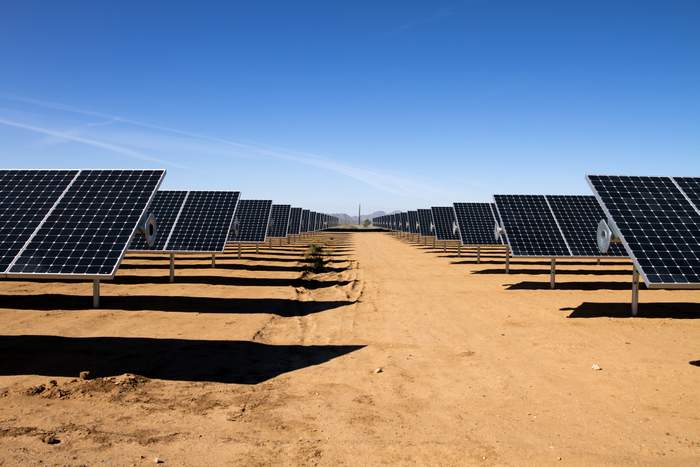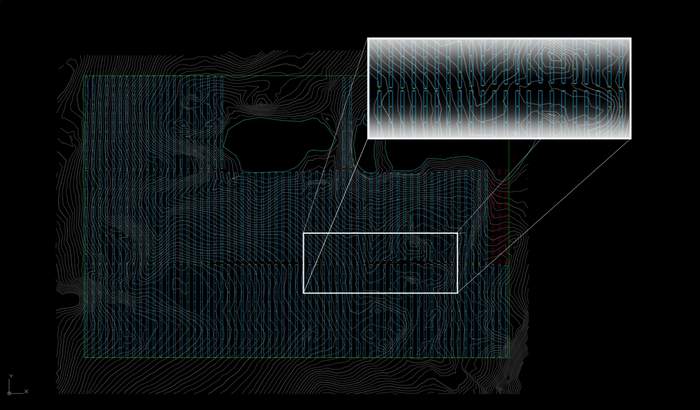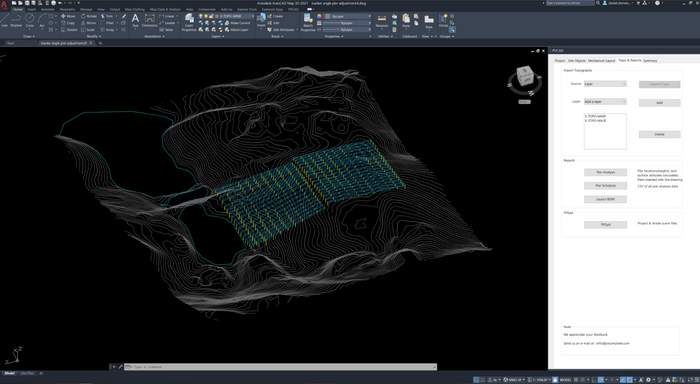As greater numbers of utility-scale solar projects are built on challenging topography that includes hilly terrain, shrinkage in utility-scale layouts is becoming increasingly common and more problematic. Shrinkage can be best described as the amount the total length of a tracker or fixed-tilt row is shortened in a top down view “as the crow flies” based on the fact that it must follow the up and down slope of the terrain undulations that it covers along the row.
As greater numbers of utility-scale solar projects are built on challenging topography that includes hilly terrain, shrinkage in utility scale layouts is becoming increasingly common and more problematic. Most utility-scale layouts do not take shrinkage into account. Instead, they rely on a bird’s eye, aerial view of a row, which makes every row appear of equal length and as if they proceed in straight lines on a level plane.
If you do not account for shrinkage in a utility-scale layout, the pier locations will be inaccurate. When trackers are not level to horizontal, piers are actually closer together in distance than they are on a site with flat terrain.
Failing to account for shrinkage may also prevent you from taking advantage of the full capacity of a site. Because rows are shortened, in some cases it is possible to fit more rows on a hilly project site than one can accommodate on a level site of the same geographic area. Consider a bed sheet. A wrinkled bed sheet with “varied topography” takes up less physical area than a flat bed sheet. If your project site is akin to a wrinkled bed sheet, there is likely additional space that can be used to fit more solar.
Almost every utility project at some point analyzes topography. The key is to leverage that information early to inform site design and ensure the best project outcomes.
Today’s most advanced solar design software includes point-cloud and contour line topo data import functionality and incorporates sophisticated topography analysis capabilities that simplify and improve the accuracy of layouts on varied terrain. Other cutting edge software features include the ability to visualize a project site in 3D and accurately account for shrinkage by wrapping the racking over the terrain contours. Layouts that take shrinkage into account are far more accurate in terms of pier locations, row lengths and total capacity.
Consider this example of a utility-scale site with hilly terrain shown in Figures 1 through 3. Figure 1 shows three rows of trackers that fill the rectangular area. Unfortunately the north end of the available area includes some designated wetlands, as shown in light blue. We are not allowed to encroach on these designated wetlands areas.
The dotted red rectangles represent trackers that need to be omitted from the layout due to these wetlands. However, we may be able to regain that anticipated production loss. Because this site is very hilly, we might find more rackable land if we take shrinkage into account.
Figure 2 shows the same layout once shrinkage is accounted for. This approach reveals how the trackers are foreshortened as they are installed up or down a slope, and that the piers are closer together along the Y axis. Notice that the gap between rows widens and narrows to account for these changes. By leveraging the extra area available in this “wrinkly” terrain, we are able to fit 15 more trackers onto the layout than appeared possible on the equivalent flat site. In essence, it is as if you have stretched out a wrinkled blanket.
In Figure 3, tilting the 3D view cube to get an isometric view of the trackers that were encroaching on the first wetland shows why this is the case. The trackers are installed on a steep angle coming down a hill towards the wetlands, allowing more installation space than would be apparent from a top down layout in which shrinkage has not been taken into account.
In conclusion, remembering to take shrinkage into account when producing solar layouts is necessary to determine accurate pier locations and may reveal some hidden benefits in the form of increased site capacity.
Daniel Sherwood, P.E. is president and co-founder of solar design software company, PVComplete.
— Solar Builder magazine





Leave a Reply
You must be logged in to post a comment.